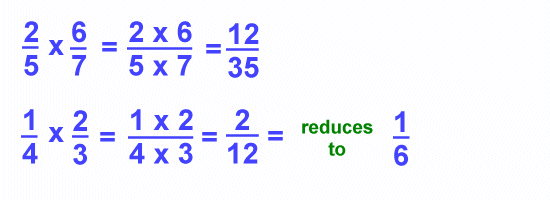Fractions name a part of a set or whole.
Equivalent Fractions
How to make an equivalent fraction
You can multiply or divide BOTH the numerator and the denominator by the SAME number to make an equivalent fraction.
Multiplying makes the numerator and denominator larger, but still equivalent.
Dividing makes the numerator and denominator smaller, but still equivalent. This is also referred to as reducing the fraction to simplest form.
Make an equivalent fraction for 2/5
1. Choose a number to multiply by. I will choose 4. (you can choose ANY number)
2. Multiply BOTH the numerator and the denominator by 4.
3. So 2 x 4 = 8 and 5 x 4 = 20
4. The new equivalent fraction for 2/5 is 8/20
Reduce 36/42 to make an equivalent fraction
1. Figure out which number has BOTH 36 and 42 as multiples
2. For these numbers, the answer would be 6.
3. divide 36 AND 42 by 6
4. So 36 divided by 6 = 6 and 42 divided by 6 = 7
5. The new reduced equivalent fraction is 6/7
Tips for Comparing Fractions
Tip #1
If the numerator is the SAME, compare the denominators.
The SMALLER the denominator, the BIGGER the fraction.
2/3 > 2/8 because the numerator is the same and since 3 is SMALLER than 8, 2/3 is the LARGER fraction.
Tip #2
If the denominator is the SAME, compare the numerator.
The BIGGER the numerator, the BIGGER the fraction.
4/6 > 2/6 because they both have a denominator of 6 and 4 is greater than 2.
Tip #3
If Tip #1 or #2 do not apply, you will need to draw a model/number line to compare.
1/2 > 3/8 because:

1/2 extends farther down the number line making it the LARGER fraction.
Check out this cool Blendspace to learn more!
Check out this fun interactive game you can play at home to practice!
https://play.kahoot.it/#/k/451a7fda-1d49-4ffb-b616-50803312dbd4
Ordering Fractions

Put these fractions in order least to greatest:
1/3, 4/6, 2/12
Step 1: Find a common denominator (a denominator that all fractions have in comon)
Think? What # can I divide 3,6,& 12 into evenly?
Answer? 12
The common denominator is 12
Step 2: make equivalent fractions with the new denominator
Change each fraction so the denominator is 12 for all three.
1/3 = 4/12 4/6 = 8/12 2/12 stays the same
(for help making equivalent fractions, see notes above)
Step 3: Put the fractions in order
Least to greatest order would now be:
2/12, 4/12, 8/12
Try these out! Bring in your work for a treat tomorrow!
Ordering Fractions
Put these fractions in order least to greatest:
1/3, 4/6, 2/12
Step 1: Find a common denominator (a denominator that all fractions have in comon)
Think? What # can I divide 3,6,& 12 into evenly?
Answer? 12
The common denominator is 12
Step 2: make equivalent fractions with the new denominator
Change each fraction so the denominator is 12 for all three.
1/3 = 4/12 4/6 = 8/12 2/12 stays the same
(for help making equivalent fractions, see notes above)
Step 3: Put the fractions in order
Least to greatest order would now be:
2/12, 4/12, 8/12
Try these out! Bring in your work for a treat tomorrow!
| Add caption |
| Add caption |



No comments:
Post a Comment